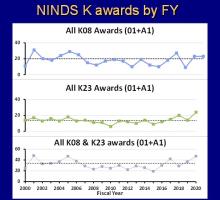
Clinician-scientists, who understand diseases and disorders intimately due to their clinical training and practice, are critical to accomplishing the NINDS mission. NINDS has many programs specifically designed to support the research career development of clinician-scientists at different career stages, including MD/PhD students (F30, F31 and T32 awards), residents and fellows (F32, R25 and T32 institutional awards) and junior faculty (K awards). Unfortunately, because of large educational debt, the choice to pursue research can come at a financial price for some clinicians, as quite often a career that includes a significant research component pays less than a full-time commitment to clinical practice. The number of K applications and the number of awards have not increased over many decades (see figure courtesy of Dr. Stephen Korn). The average success rate for a K08 applicant in the past 4 years is 51%, and 41% for K23 applicants.
The NIH Loan Repayment Program (LRP) is a congressionally mandated program that was designed to address this problem. The LRP will pay off educational debt of health professionals who are dedicated to pursuing research as a significant component of their professional activities. Specifically, the LRP will provide up to $50,000 per year in educational debt relief, and also pay the taxes associated with the added income provided by the LRP. NINDS currently commits over $4.1 million annually to the LRP program.
NINDS prioritizes applicants who show a clear and on-going dedication to research and the ability or potential to develop a successful career as an independent investigator. LRP will support clinician-scientists engaged in research funded by NIH as well as by private sources. Eligible clinician-scientists with K award funding are very highly likely of receiving LRP support – over a recent 6-year period, 100% of K awardees who applied to NINDS for LRP support got it. In addition, residents and fellows who have received competitive research funding of any kind (public or private) are highly competitive for LRP support. Importantly, there is no limit to the number of times one can apply for LRP support. So, applicants who apply and don’t obtain LRP support in a particular year can continue to apply every year thereafter as long as they meet the eligibility criteria. Moreover, even after a successful application, one can continue to apply yearly as long as the debt load meets eligibility criteria. Over 90% of clinician-scientists who received LRP support from NINDS between 2005-2010 are still active in research today.
Unfortunately, based on the historical, congressional mandate underlying the program, many clinician-scientists were excluded from eligibility. Until 2021, LRP support at NINDS could only be obtained by individuals conducting one of three categories of research: clinical research (research that directly involved human subjects), pediatric research or health disparities research. This meant that clinician-scientists doing basic, non-pediatric research, who account for about 50% of NINDS clinician-scientists with K awards, were ineligible for LRP support. This glaring gap in eligibility has now changed. Starting in 2022 (application deadline in Fall 2021), NIH will add a major new category of research that is eligible for LRP support. This new LRP category, called REACH (Research in Emerging Areas Critical to Human Health), will make LRP support available to virtually all clinician-scientists at NINDS.
Unlike grants for training or research, the research itself in a loan repayment application is not critiqued. Instead, what is critical is the thoughtfulness of the planning and demonstration of a commitment from the applicant and mentor toward the goal of becoming an independent investigator (please see the NINDS LRP website for more information).
Our investment in the neuroscience workforce continues to be of the utmost priority to our mission. LRPs are an important way for us to recruit and retain highly trained individuals in neuroscience research who may otherwise feel pressured to choose other career paths. Indeed, the fact that over 90% of clinician-scientists who obtain LRP support remain active in scientific research long after obtaining support demonstrates that the LRP can make a scientific career financially viable for a clinician.
Please help us spread the message about these programs, and if you are eligible, consider applying! Application information and instructions regarding these extramural loan repayment programs can be found on the NIH Loan Repayment Program website. We also strongly encourage you to check out the NINDS LRP website for important information about applying for LRP support from NINDS. NINDS has a wonderful team devoted to building and nurturing the next generation of NINDS grantees.
